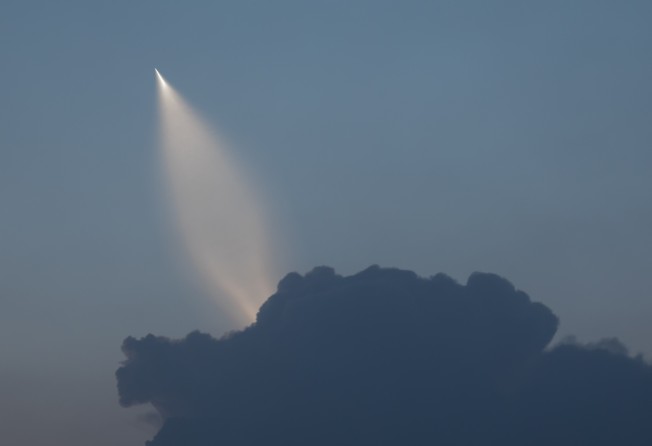
China tests missile – but here’s why it wasn’t a next-generation JL-3
- Sunday’s test firing involved mid-range Dongfeng missile with improved guidance systems
- It coincided with the last day of the Shangri-La Dialogue in Singapore, Asia’s biggest security forum

A missile test by the People’s Liberation Army on Sunday did not feature the country’s next-generation long-range weapon, but instead involved a mid-range Dongfeng missile refitted with improved guidance systems, according to Beijing military sources.
The test was not publicly announced but coincided with a notice issued by the Liaoning Maritime Safety Administration last week declaring the Bohai Bay area – the innermost gulf of the Yellow Sea in northeast China – off-limits to marine traffic from the early morning until noon on Sunday.
The notice triggered speculation among military observers that China might have test-fired its next generation, submarine-launched, strategic JL-3 missile.
Soon after the test, Chinese social media was flooded with messages from people claiming they had spotted a UFO and images of a flying object with a long white tail of smoke in the sky.
On Monday, the PLA’s Rocket Force, the unit that runs China’s missile programme, posted a photo of a missile on a mobile launcher on Weibo, the Twitter-like microblogging platform, accompanied by the rhetorical question: “Do you believe in UFOs?”
This was soon matched by the Chinese navy which posted a photo of a missile being launched from the sea, and asking the same question, “Do you still believe in UFOs?”
The tacit encouragement fuelled a frenzy of Chinese media reports trumpeting the “success” of the missile test, with some carrying headlines referring to “Big Waves” – the Chinese name for the JL-3 or Julang missile – as the punchline. Some even boasted that the test confirmed that the PLA had real muscle.
But two military sources told the South China Morning Post that the missile tested on Sunday was a land-based, mid-range Dongfeng missile launched from Taian in the eastern province of Shandong, while Bohai Bay was closed for another, routine military exercise.

The test coincided with the last day of the Shangri-La Dialogue in Singapore, Asia’s biggest security forum, which this year was attended by Chinese Defence Minister General Wei Fenghe.
Wei issued a stern warning at the forum on Sunday to “external forces” fostering the idea of independence for Taiwan. He also said China’s construction of artificial islands in the South China Sea was its “legitimate right”.
“China wouldn’t test a strategic missile like the JL-3 at such a sensitive time, when China and the US are locked in a trade war and Chinese generals are meeting foreign counterparts in Singapore,” one of the sources said.
“According to publicly available video, the object’s flight path was different from and its height much lower than that of the JL-3.”
Collin Koh, a military analyst from the S. Rajaratnam School of International Studies at Singapore’s Nanyang Technological University, said the media hype, which was deliberately left uncorrected, had been used to address public concerns and expectations in China.
“Sometimes it’s difficult to conceal military activities and missile launches can be observed by the public, such as the rocket trails and light,” Koh said.
“The Weibo posts left it up to the domestic and external audience to imagine whether it was land or submarine launched. Deterrence may be enhanced through such strategic ambiguity.”
The intercontinental JL, or Julang series – meaning “big wave” in Chinese – is designed for China’s nuclear-powered submarines, as part of the PLA’s strategy to extend the country’s nuclear deterrent capabilities from land to sea.
China first launched the JL-3, which could deliver a nuclear strike to any country in the world, from a Type 032 Qing-class auxiliary submarine in Bohai Bay in January.
The third-generation JL-3 has a flight range of about 9,000km (5,600 miles) – a significant advance on the JL-2, which has a 7,000km reach. But it is still less than the 12,000km range of the American Trident II and Russian Bulava submarine-launched ballistic missiles.
A second source said China conducted more than 100 missile tests every year to assess newly added systems.
“As the DF series missiles are ageing, China has to make improvements and test those improvements,” the source said.
“And the military exercise in Bohai on Sunday was not the launch of a JL-3 – it was another, previously scheduled, live-fire exercise by the Chinese navy.”
China has four nuclear-powered submarines, each outfitted with 16 JL-2 missiles, but the Type 096 next-generation submarines will be able to carry up to 24 JL-3s, according to an annual Pentagon report to the US Congress about China’s military build-up.
Meanwhile, the US Navy has 18 Ohio-class nuclear-powered submarines, with 14 capable of carrying up to 24 powerful Trident I missiles.